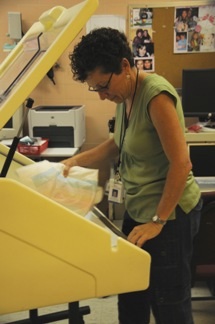非常抱歉,
你要访问的页面不存在,
非常抱歉,
你要访问的页面不存在,
非常抱歉,
你要访问的页面不存在,
验证码:

职称:Professor of Otolaryngology Keck School of Medicine University of Southern California
所属学校:University of Southern California
所属院系:Neuroscience
所属专业:Neuroscience
联系方式: (323) 865-1281
House Ear Institute, Los Angeles, CA [Postdoc Auditory Development (1993-1995)] University of Washington, Seattle, WA [Ph.D. Hearing Science (1993)] University of California, Santa Barbara, CA [M.A Hearing Science (1986)] California State University, Fullerton, CA [B.A. Communicative Disorders (1983)]
Human Cochlear Function: A Continuum of Maturation and Aging. This project studies changes in cochlear function throughout the human lifespan, defining the timeline for these age-related shifts and the mechanisms driving the changes. We use primarily otoacaoustic emissions, a noninvasive probe of cochlear mechanics to learn about the human peripheral system. We apply both distortion- (DPOAE) and reflection-source (stimulus frequency OAEs and the reflection-component of the DPOAE) emissions using custom-algorithms, innovative swept-tone methodology and advanced analysis schemes. We disentangle the origin of age-related effects by separating distortion product OAEs into their dual components, distortion and reflection; and studying how each components phase and amplitude is impacted throughout the human lifespan. In our lab it is important to study both apical and basal halves of the cochlea to yield a more comprehensive understanding of mechanics. The apex has been minimally studied in humans, and wholly unexplored during maturation. Yet, we have recently reported striking immaturities in DPOAE phase for low-frequency signals coded in the apex of neonates. Our exploration of human cochlear function from base to apex using multiple OAE sources establishes a normative framework, provides detailed information about how the newborn cochlea works and how the elderly cochlea ages. This information contributes to more comprehensive cochlear models and toward the development of more innovative probes of cochlear mechanics for human application. This project is funded by the NIH-NICDC. Exploiting Dual OAE Sources to Study the Normal and Impaired Human Cochlea. This project attempts to exploit the distinct information embedded in both reflection- and distortion-source OAEs to create a more comprehensive and descriptive assessment of cochlear function. At present, OAEs are used in a categorical sense, simply to detect hearing loss. However, the ample information offer by each OAE-source (i.e. linear reflection and nonlinear distortion) provides distinct clues about cochlear mechanics. We wish to exploit this distinct information describe (not just detect) sensorineural hearing loss (SNHL). At present, SNHL is a catch-all term, defined by degree of loss and audiometric configuration. However, two hearing losses with identical audiograms can produce varying perceptual difficulties and varied success with hearing aids. By recording reflection and distortion emissions together over a broad parametric space to examine level-dependence, we may be able to learn more about the underlying deficits that make up the broad category of SNHL. When used in combination, the properties embodied by each emission source can be considered in one metric. We are currently developing and testing this joint OAE protocol by recording stimulus frequency OAEs and the distortion component of DPOAEs in ears with normal and impaired hearing. We hypothesize that normal-hearing ears show a typical cluster of reflection-to-distortion features, and ears with hearing loss will show features that fall outside of this normative space. Furthermore, we expect that hearing impaired ears with common deficits will form clusters that provide useful in diagnostics and intervention. This project is done in collaboration with fellow USC faculty member, Dr. Radha Kalluri.